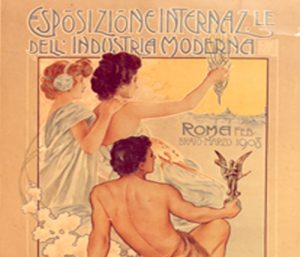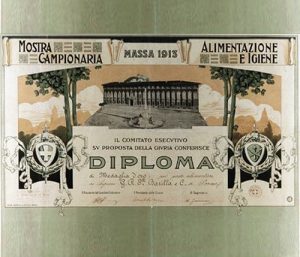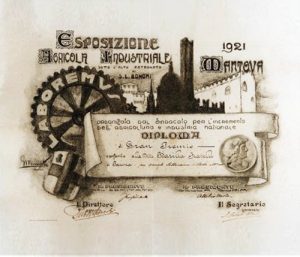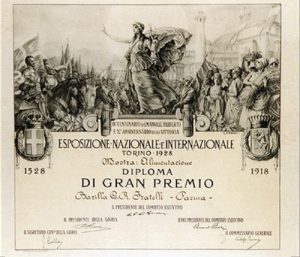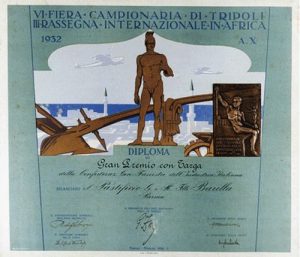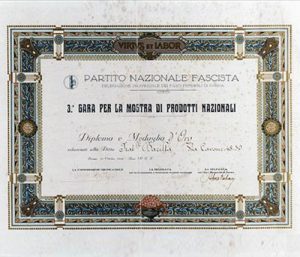Awards for fairs and exhibitions
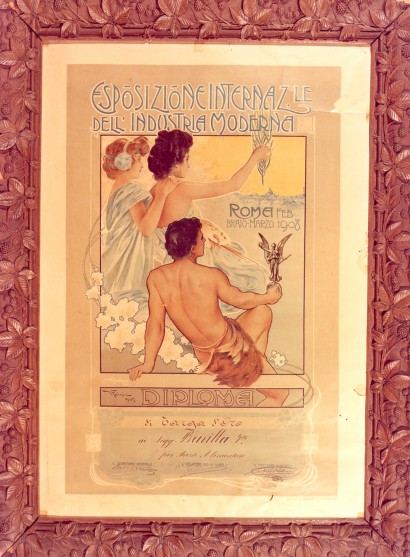
by Roberto Pagliari
These awards have been a constant in the history of the Company over time and find an ideal match in Barilla’s activity at trade fairs.
We must note that Barilla always demonstrated a clear corporate strategy in this aspect: as early as in 1908, when it was still a small shop in the historic center of Parma, it found a way to take part in the Modern International Expo of Rome, where it obtained the Gold Plate Diploma for pasta, in recognition of the quality of products.
This is an important document, preserved in its contemporary frame ornate with Art Nouveau-style vegetable motifs, and precedes the opening of the industrial activity by two years. The author of the lithography, which shows the outlines of two female figures representing the Arts and a male figure representing Commerce portrayed in front of a landscape of Rome, is Virgilio Faini (1872-1973), son of the industrialist Giuseppe Faini (producer of “fainite” gunpowder). He graduated from the Academy of Fine Arts in Florence, becoming an excellent etching artist and reproducing works by old masters kept at the Uffizi museum in Florence. Painter and publicist, an expert in production of fine replicas of antique prints, Faini also cultivated a great passion for the theater where he made his debut in 1914 at an early age.
For his beauty, the diploma was showed at the exhibition “For honor and merit. History, art and styles in the diplomas of merit between the 19th and 20th centuries” held in Parma at the “Glauco Lombardi” Museum in 2019.
The Barilla stands have always been prominent elements at trade fairs, as they were built with a rigorous method, so that they could be remembered by the public.
In 1913 Barilla took part in the Food and Hygiene Sample Show in Massa, where Barilla obtained a Gold Medal with a paper diploma depicting the facade of the exhibition building of the Tuscan town in its center. It is still preserved in the Historical Archive, and although it is not an award of high relevance, it testifies to the Company’s propensity to make itself known to the outside world, to leave the province, to open up to the world.
In 1921 Barilla inaugurated a new season of successes and confirmed itself locally as a leading company in the production of egg pasta, winning the Grand Prize Diploma at the Agricultural and Industrial Exhibition of Mantua, organized under the high patronage of Minister Bonomi. The award is a lithographic print on rectangular paper, printed by the Officine Mondadori of Verona, and depicting the profile of the monumental buildings of the Lombard town flanked by a toothed wheel bearing the motto “Laboremus” – let us work, holding a cartouche with the dedication.
In 1928 the Barilla stand at the Turin International Exposition, designed by architect Mario Bacciocchi (1902-1974), won the bronze plaque depicting two winged figures in relief supporting a golden medallion depicting Emanuele Filiberto of Savoy on horseback.
In 1932 Barilla achieved the Grand Prix with a bronze plaque for its participation in the VI edition of the Tripoli Trade Fair – III International Review in Africa. The presence of the Company must be linked to the marketing initiatives (following agreements with Galbani of Melzo) of Barilla products in the Italian colonies. The author of the diploma, depicting the panorama of the port of Tripoli with a classical sculpture and a plow in the foreground, is Giuseppe Rondini (1885-1955). Born in Palermo, Rondini moved to Rome at a very young age and there he attended the Academy of Fine Arts. He was one of the first to follow the rebirth movement of woodblock art, immediately establishing himself as a black and white etching artist. He was also a highly regarded painter and etching engraver and designed and engraved a good number of post stamps for the Italian State Printing Office and Mint. He worked as an illustrator of books for colonial schools and created the poster for the Leather Tanning Exhibition of the Italian Colonies. After the untimely death of his wife, Ulderica Persichini, who for love of him abandoned a well-established career as a soprano, he retired to monastic life in Grottaferrata, where he died and where a street was named after him. This diploma was also exhibited at the exhibition “For honor and merit. History, art and styles in the diplomas of merit between the 19th and 20th centuries” held in Parma at the “Glauco Lombardi” Museum in 2019.
As we know, Barilla began its business in 1877 with a bread and pasta shop in Strada Vittorio Emanuele 252 in Parma. This shop was the first of a series opened in various areas of the city (Via Saffi, Via Cavour, Via Farini) and constituted a network that was discontinued after World War II. The interiors of the shops were very refined, thanks to the design of top-level architects such as the aforementioned Mario Bacciocchi and entrusted to the experienced hands of craftsmen specializing in woodworking, glass and ceramic works. In particular, the shop on Via Cavour won a medal and a diploma at the third contest for the exhibit of national products organized in Parma in 1929.
